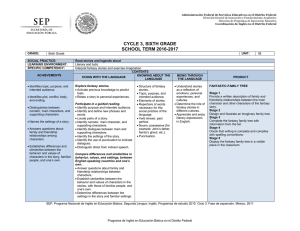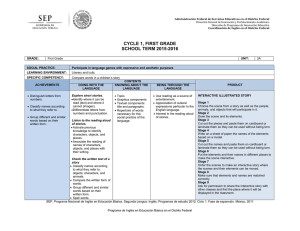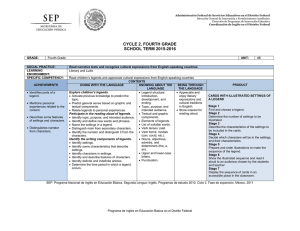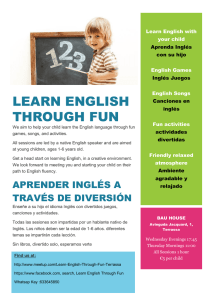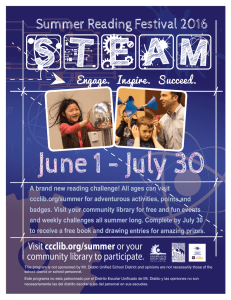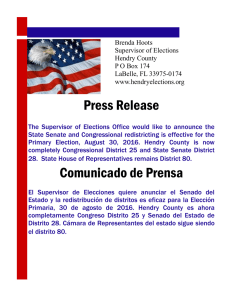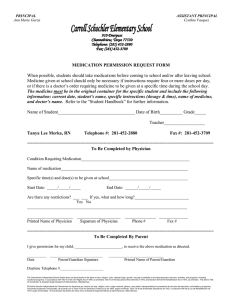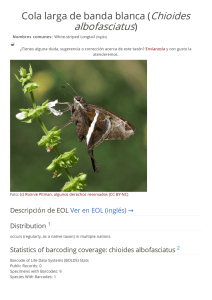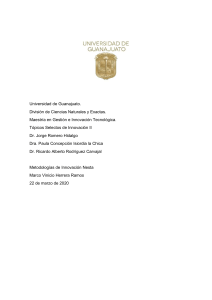cycle 1, preschool school term 2015-2016
Anuncio
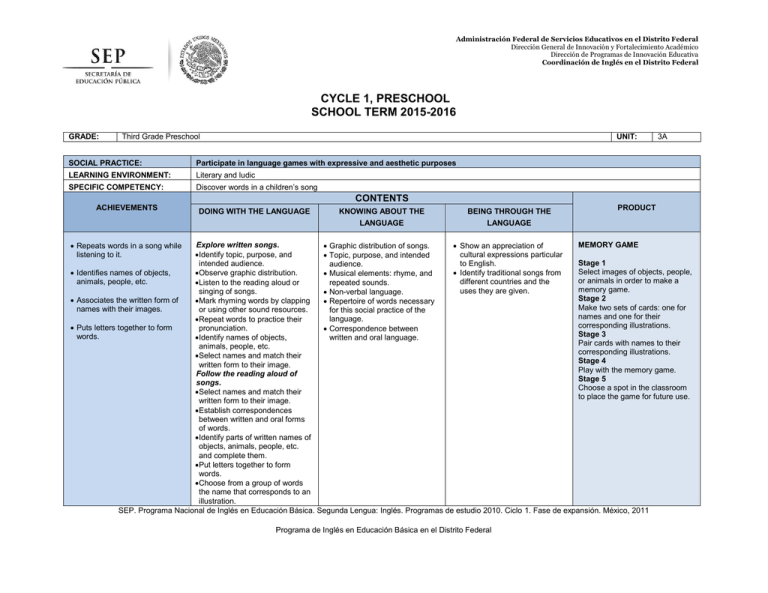
Administración Federal de Servicios Educativos en el Distrito Federal Dirección General de Innovación y Fortalecimiento Académico Dirección de Programas de Innovación Educativa Coordinación de Inglés en el Distrito Federal CYCLE 1, PRESCHOOL SCHOOL TERM 2015-2016 GRADE: UNIT: Third Grade Preschool SOCIAL PRACTICE: Participate in language games with expressive and aesthetic purposes LEARNING ENVIRONMENT: Literary and ludic SPECIFIC COMPETENCY: Discover words in a children’s song 3A CONTENTS ACHIEVEMENTS DOING WITH THE LANGUAGE KNOWING ABOUT THE LANGUAGE BEING THROUGH THE LANGUAGE Repeats words in a song while listening to it. PRODUCT Explore written songs. MEMORY GAME Graphic distribution of songs. Show an appreciation of Identify topic, purpose, and cultural expressions particular Topic, purpose, and intended Stage 1 intended audience. to English. audience. Select images of objects, people, Identifies names of objects, Observe graphic distribution. Identify traditional songs from Musical elements: rhyme, and or animals in order to make a animals, people, etc. different countries and the Listen to the reading aloud or repeated sounds. memory game. uses they are given. singing of songs. Non-verbal language. Stage 2 Associates the written form of Mark rhyming words by clapping Repertoire of words necessary Make two sets of cards: one for names with their images. or using other sound resources. for this social practice of the names and one for their language. Repeat words to practice their corresponding illustrations. Puts letters together to form pronunciation. Correspondence between Stage 3 words. written and oral language. Identify names of objects, Pair cards with names to their animals, people, etc. corresponding illustrations. Select names and match their Stage 4 written form to their image. Play with the memory game. Follow the reading aloud of Stage 5 songs. Choose a spot in the classroom Select names and match their to place the game for future use. written form to their image. Establish correspondences between written and oral forms of words. Identify parts of written names of objects, animals, people, etc. and complete them. Put letters together to form words. Choose from a group of words the name that corresponds to an illustration. SEP. Programa Nacional de Inglés en Educación Básica. Segunda Lengua: Inglés. Programas de estudio 2010. Ciclo 1. Fase de expansión. México, 2011 Programa de Inglés en Educación Básica en el Distrito Federal Administración Federal de Servicios Educativos en el Distrito Federal Dirección General de Innovación y Fortalecimiento Académico Dirección de Programas de Innovación Educativa Coordinación de Inglés en el Distrito Federal SUPPLEMENTAL EDUCATIONAL MATERIALS Big Books e.g. Hats On Big Book 1: Unit 7: What’s this? e.g. Hats On Big Book 2: Unit 8: The new car e.g. Hats On Big Book 3: Unit 3: All about fish Thematic Frame Seek to promote English learning through the contents of different areas, the exploration of each unit makes it possible to develop language skills in tandem to create interest in issues that promote the imagination of students and sensitize them. Early literacy plays a fundamental part in each unit, taking into account the different learning styles and motivating children to show more self-confidence, which is key in all areas of development. Macmillan Early Learners Flashcards Motivate students to relate the images and texts through diverse activities Implement dynamic and games according to their level increasing the degree of complexity. Perform reviews of the vocabulary learned during the sessions. Invite students to repeat the words learned making it visible their pronunciation. Encourage students to classify images according to the topics covered. Hats On Concept Mats It is additional material to the Big Books that seeks to promote the learning of the English language from a range of activities integrated to the contents of each unit, contributing to the consolidation of vocabulary, language practice and the development of mathematical and social skills. These materials (HATS ON CONCEPTS) are to be used in a wide range of opportunities focused on the approach to a second language (English), its production, the review and consolidation of vocabulary as well as favoring communicative situations and the development of socialization language skills. Programa de Inglés en Educación Básica en el Distrito Federal Administración Federal de Servicios Educativos en el Distrito Federal Dirección General de Innovación y Fortalecimiento Académico Dirección de Programas de Innovación Educativa Coordinación de Inglés en el Distrito Federal PRODUCT STAGES SUGGESTED ACTIVITIES Stage 1 Stage 2 Stage 3 Have Ss point at different objects or vocabulary items whenever they listen to them identifying spelling for the target vocabulary Ask Ss to bring cut outs of the vocabulary items under study to be pasted on pieces of cardboard or provide Ss with magazines to take the cuttings from. Have Ss retrace and/or complete in one of its letters some chosen words in order for them to identify the written form of them. Provide Ss with plastic small letters, letters on pieces of paper or cardboard, etc., to form words. Have them work in small groups. Provide Ss with pieces of cardboard with the written form of words in dotted lines for Ss to re-trace. Walk around monitoring Ss’ work. You can even have different lexical sets for different memory card sets, e.g., make different teams and assign each team an element to work on such as people, classroom objects or animals. Organize teams so that Ss start learning what collaborative work is, guide the class and say words aloud or use songs so that Ss raise the hand every time they identify a word and then ask them to show the rest of the class the illustration that correspond to the word they hear. Encourage Ss to continue working in teams and organize their set of cards in different lexical sets: classroom objects, people or animals. Hide the cards with illustrations all into the classroom and give the Ss the written version of each card so that they have to find the picture for their card or vice versa. Paste the cards randomly on some Ss’ chest or one or their shoulders and have some other pair them. Stage 4 & 5 In order to get Ss attention and involve everyone, ask them to show their partners what they have in their back packs, distribute school objects’ labels for them to stick on their belongings. Ask Ss to bring illustrations of their favorite animal or the pet they have at home, Ss can also share with the whole class who the members of their family are. Previous modeling could help Ss know what they have to do.. Start each session by singing different songs related to classroom objects, people or animals. On subsequent occasions, highlight the words under study by pausing every time there is a familiar word for Ss. Emphasize its pronunciation. Select a song and provide Ss with a complete or partial printed version of the song in order for them to become familiar with the graphic presentation of some words. Bring along several visual elements for Ss to associate them to the previous vocabulary items. Ask Ss to follow the sequence of the song with the aid of illustrations. Act or mime words from the target vocabulary and have Ss do it as well. Place some loops, boxes, baskets, etc. on the floor and mix the different lexical sets Ss have done so that they can categorize the pictures or the words according to some criteria previously established. Sit along with the Ss as to form a big circle on the floor and play with the big memory game. Exhibit the different lexical card memory games on one of walls and try to use them on further activities. Ss may play once with one lexical set of cards and then change to another small group with a different one. Ss are asked to match the cards with the written form of the objects used for the purpose. Do this in teams for a contest. Programa de Inglés en Educación Básica en el Distrito Federal Administración Federal de Servicios Educativos en el Distrito Federal Dirección General de Innovación y Fortalecimiento Académico Dirección de Programas de Innovación Educativa Coordinación de Inglés en el Distrito Federal Books Publishing House Teacher’s Book Activity Book Big Book "Brilliant K" Santillana pp. 53-61 pp. 47-56 Fact Book pp. 15-20 "Come on! Preschool" Esfinge pp. 55-67 pp. 32-38 Non-Fiction pp. 22-37 “Do it! Preschool” University of Dayton pp. 55-65 pp. 31-37 Fact Book pp. 26-33 “English 3 Grade” Fernández Editores pp. 66-78 pp. 55-67 Tale Book pp. 17- 24 “I’m ready! P” Macmillan pp. 67-77 pp. 46-55 Fact Book pp. 22-31 “Play and Do Preschool” Trillas pp. 59-65 pp. 37-43 Our world 19-28 "Play and Play K" Nuevo México pp. 56-65 pp. 48-55 Non-fictional pp. 19-26 “Think! In English P” Ediciones SM pp. 55-64 pp. 34-39 Fact-Book pp. 25-33 "Yes, we can! K” Richmond” pp. 36-43 pp. 36-43 Nonfiction pp. 19-28 rd WEBSITE RESOURCES http://www.learninggamesforkids.com/preschool_games.html http://www.learnenglishkids.britishcouncil.org http://www.preschoolexpress.com/music_station.shtml http://www.preschoolrainbow.org/preschool-rhymes.htm http://www.songsforteaching.com/preschoolkindergarten.htm N.B. Website resources and supporting materials are suggestions which require suitable adjustments and content analysis in order to include them as part of the didactic sequence according to every particular classroom reality and student´s needs and preferences. Programa de Inglés en Educación Básica en el Distrito Federal
